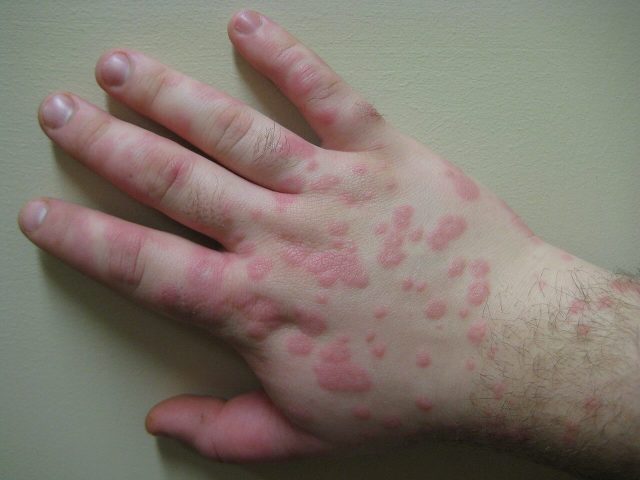### Date : 2024-06-23 19:25
### Topic : Difference Between Erythema and Petechiae #medicine #dermatology
----
### Difference Between Erythema and Petechiae
**Erythema** and **petechiae** are both skin manifestations but have distinct causes, appearances, and implications. Understanding their differences is crucial for accurate diagnosis and management.
### Erythema

<Photo from: https://www.drugwatch.com/health/rash-and-skin-disorders/erythema/>
**Definition:**
- Erythema is a redness of the skin caused by increased blood flow (hyperemia) in the superficial capillaries. It can result from various factors, including inflammation, infection, or skin irritation.
**Causes:**
- Inflammatory responses (e.g., infections, allergic reactions, autoimmune diseases)
- Sunburn or heat exposure
- Physical irritation (e.g., rubbing, pressure)
- Certain medications or treatments
**Appearance:**
- Red, pink, or warm areas on the skin that ==blanch (turn white) when pressed==. This blanching occurs because the increased blood flow can be temporarily displaced by pressure.
**Common Conditions:**
- Erythema nodosum
- Erythema multiforme
- Erythema migrans (associated with Lyme disease)
- Sunburn
**Diagnosis:**
- Clinical evaluation based on the appearance and distribution of redness
- Medical history and examination to identify underlying causes
**Treatment:**
- Depends on the underlying cause (e.g., treating infections, avoiding irritants, using anti-inflammatory medications)
### Petechiae

<Photo from: https://qph.cf2.quoracdn.net/main-qimg-e2d4b7eb4c762ec8f6596307f9bb79ce-lq>
**Definition:**
- Petechiae are small, pinpoint hemorrhages under the skin caused by bleeding from capillaries. They are often a sign of a more serious condition affecting the blood or blood vessels.
**Causes:**
- Trauma or injury to the skin
- Infections (e.g., bacterial, viral, rickettsial)
- Blood disorders (e.g., thrombocytopenia, leukemia)
- Vasculitis
- Certain medications (e.g., anticoagulants, aspirin)
**Appearance:**
- Tiny, red, brown, or purple spots less than 2 mm in diameter. ==They do not blanch when pressed because the blood has leaked out of the capillaries ==and is no longer within the vessels.
**Common Conditions:**
- Thrombocytopenia (low platelet count)
- Meningococcal infection
- Viral hemorrhagic fevers
- Leukemia
- Vasculitis
**Diagnosis:**
- Clinical evaluation based on the appearance and distribution of petechiae
- Laboratory tests to assess platelet count, coagulation status, and underlying infections or systemic diseases
**Treatment:**
- Depends on the underlying cause (e.g., treating infections, managing blood disorders, discontinuing causative medications)
### Comparison Table
| Feature | Erythema | Petechiae |
|-------------------|---------------------------------------|----------------------------------------|
| **Definition** | Redness of the skin due to increased blood flow in superficial capillaries | Small, pinpoint hemorrhages under the skin due to capillary bleeding |
| **Causes** | Inflammation, infection, irritation, heat, certain medications | Trauma, infections, blood disorders, vasculitis, certain medications |
| **Appearance** | Red or pink areas that blanch when pressed | Tiny red, brown, or purple spots that do not blanch when pressed |
| **Common Conditions** | Erythema nodosum, erythema multiforme, sunburn | Thrombocytopenia, meningococcal infection, leukemia, vasculitis |
| **Diagnosis** | Clinical evaluation, medical history | Clinical evaluation, laboratory tests (platelet count, coagulation) |
| **Treatment** | Based on underlying cause (anti-inflammatories, avoiding irritants) | Based on underlying cause (treating infections, managing blood disorders) |
### Conclusion
While both erythema and petechiae present as red discolorations on the skin, they have different underlying mechanisms, appearances, and clinical implications. Erythema is caused by increased blood flow and blanches under pressure, while petechiae result from capillary bleeding and do not blanch. Proper diagnosis and treatment require careful evaluation of the underlying causes and associated symptoms.